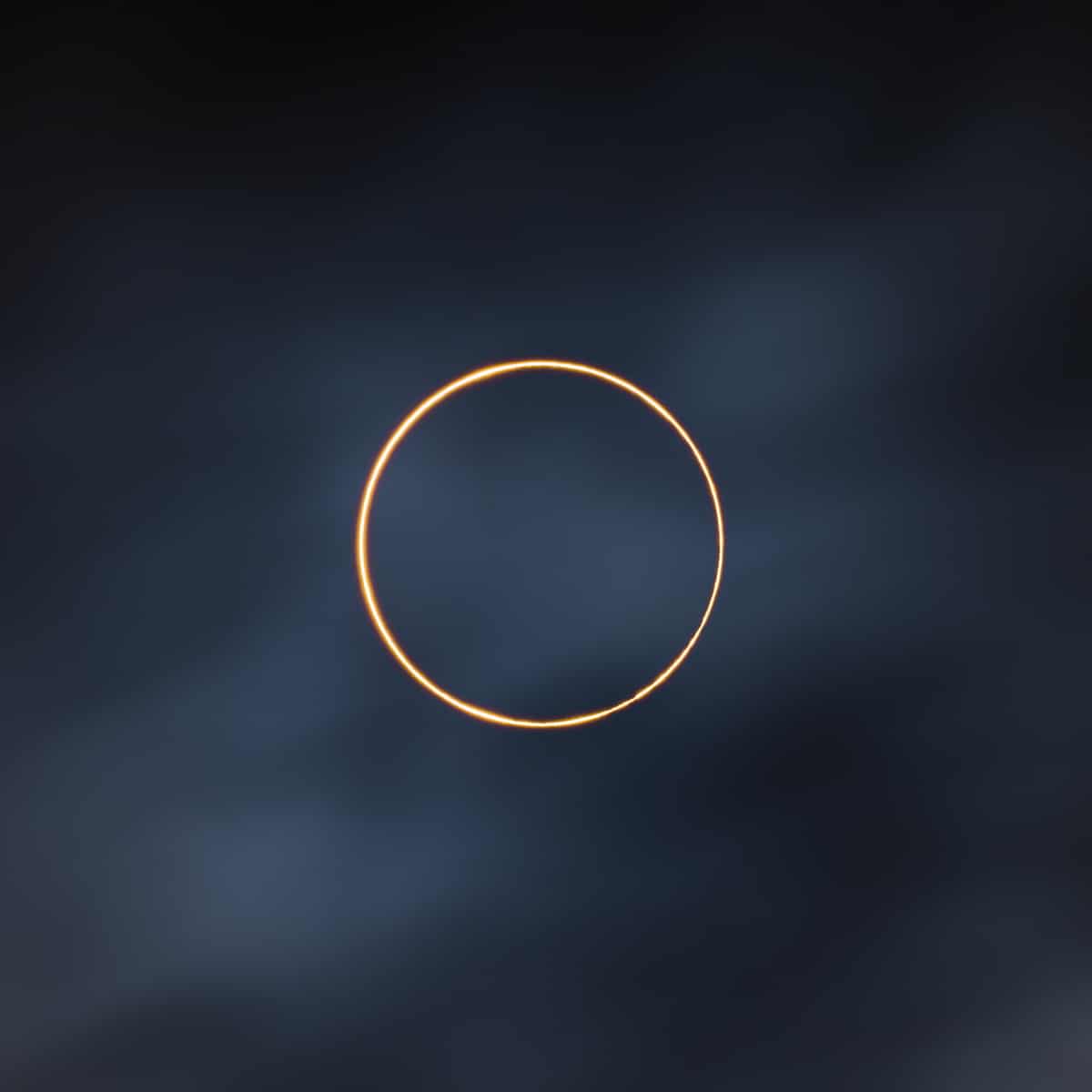
“The Golden Ring” by Shuchang Dong (China). Overall Winner, Winner – Our Sun.
On 21 June 2020, there was an annular solar eclipse and the photographer made sure not to miss it. He decided to go to Ali in Tibet to shoot it because it has year-round sunny weather. However, during the annular eclipse, there were dark clouds all over the sky. The anticipation was high but within a minute of the annular eclipse, the sunshine pierced through the clouds, and the photographer was lucky to capture that moment. Afterward, the Sun disappeared again.
Ali, Tibet, China, 21 June 2020
A photograph of the annular solar eclipse taken in Tibet has been awarded the top prize at the prestigious Royal Observatory Greenwich Astronomy Photographer of the Year awards. Chinese photographer Shuchang Dong came away with the award in the 13th iteration of the contest, which celebrates the artistry of astrophotography.
“Powerful, dramatic, and profound in its simplicity,” said competition judge Jon Culshaw. “This image constantly draws the eye back to it, away from all others. Like an image millions of years from now when the Moon has moved far enough away from the Earth. Total solar eclipses shall be no more and only annulars will remain. The technical excellence of this shot, as well as its stark beauty, impressed the astrophotographers amongst the judges.”
The winning photo is just one of many incredible images to come out of the contest. Astrophotographers from around the world have once again put their best foot forward and submitted memorable imagery. This includes a colorful look at the California Nebula by UK photographer Terry Hancock, which was captured over the course of seven nights. Another memorable winner, this time from the Skyscape category, was taken by American photographer Jeffrey Lovelace. His composition of a crescent moon over the sand dunes of Death Valley is a mesmerizing, and tranquil, view of the desert.
The winners will see their work go on display in the Astronomy Photographer of the Year 13 exhibition at the National Maritime Museum in Greenwich. The show opens to the public on September 18, 2021. This year’s winners, shortlisted entries, and a selection of previous winners will also be published by Collins in the competition’s official book, available for pre-order exclusively at Royal Museums Greenwich shops and online, and on sale across all UK bookstores from September 30, 2021.
Enjoy more award-winning astrophotography from the Astronomy Photographer of the Year contest.

“California Dreamin' NGC 1499” by Terry Hancock (UK). Winner – Stars and Nebulae.
The California Nebula, otherwise known as NGC 1499, was captured over seven nights in 2021 using broadband and narrowband filters, with a total integration time of 16.1 hours. This emission nebula is around 100 light-years long and 1,000 light-years away from Earth. It is named California Nebula because it appears to resemble the outline of the US State of California. The raw data was pre-processed and the stars were removed using a tool called Starnet, then later replaced during post-processing with the more naturally colored stars from the RGB (red, green, blue) data. In this Hubble Palette version, the hydrogen-alpha is mapped to green, singly ionized sulfur (SII) is mapped to red and doubly ionized oxygen (OIII) is mapped to the blue channel. While the colors in this image are not the true colors, the narrowband filters reveal much more of the hidden gasses not visible in a broadband image.
Whitewater, Colorado, USA.

“Luna Dunes” by Jeffrey Lovelace (USA). Winner – Skyscapes
The smoldering crescent Moon floats in an ocean blue atmosphere above quiet, glowing dunes of sand and the red of the sunset has faded into the blue twilight. The photographer hiked deep into the dunes and eventually found the foreground he had imagined for this shot. Once everything was assembled, he looked up, and there hung a shining sliver of a crescent moon outlining its dark but visible face. This HDR/perspective blend integrates four images, all shot that evening with the same 70–200-mm lens, and from the same tripod location. The images were combined in Photoshop and together they effectively replicate the sublime scene the photographer witnessed that evening.
Death Valley National Park, California, USA.
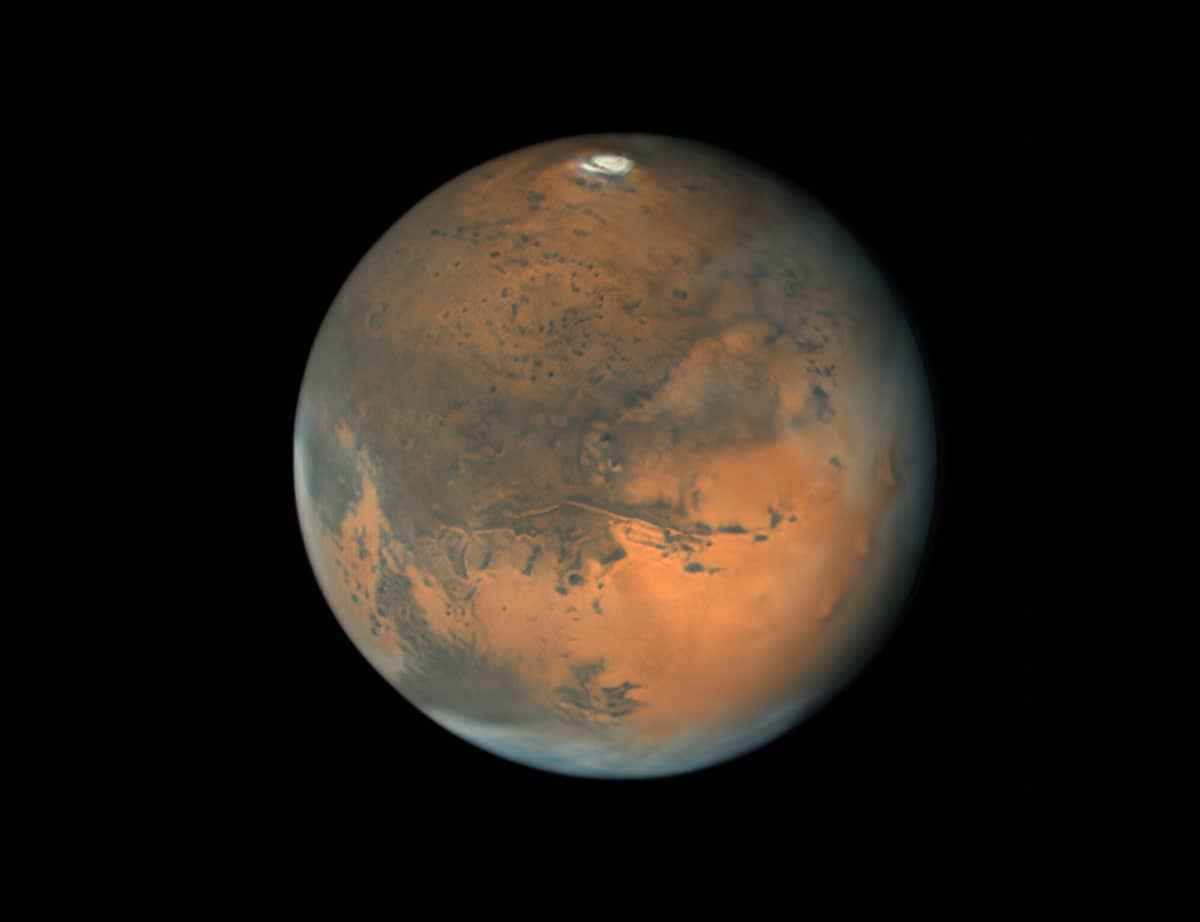
“Perseverance” by Damian Peach (UK). Runner-Up – Planets, Comets, and Asteroids.
This view of Mars is the best result of the 2020 Mars season. Which for the photographer, entailed more than a hundred nights of observations to catch the exceptional conditions that allowed for the image to be captured. It is centered on the giant Valles Marineris canyon system which is almost dead centre in this view. To the right of the image the three giant Tharsis Montes volcanoes, all around 19 kilometers high, emerge from the morning terminator surrounded by clouds. The famous ‘Eye of Mars' (Solis Lacus) is prominent right of the center. The icy south polar cap is at the top with a prominent rift splitting it in two. The photographer chose the image title to commemorate not only the recent landing of the Perseverance rover but also as it reflects the very quality that was required to achieve this result.
El Sauce Observatory, Río Hurtado, Coquimbo Region, Chile.

“Polar Lights Dance” by Dmitrii Rybalka (Russia). Winner – Aurorae.
As Third Officer, the photographer was keeping watch that night on the bridge of the ship when he noticed in the sky a tiny white band approaching like a snake. He had a feeling that there was something in the air, that something great would happen, and instantly knew that this was what he was waiting for. He took his camera, went to the bridge wing, took position, and started waiting. A few minutes later, the sky was full of bright green lights dancing in darkness and shining over everything on their way. The photographer felt that it was his mission to share this beauty with the world.
Approach to the Kara Strait, Russia.

“The Milky Ring” by Zhong Wu (China). Winner – Galaxies.
An expanse of cosmic dust, stars, and nebulae along the plane of the Milky Way galaxy form a magnificent ring in this image. The panorama covers the entire galaxy visible from planet Earth. It is an ambitious 360-degree mosaic that took the photographer two years to complete. Northern hemisphere sites in China and southern hemisphere sites in New Zealand were used to collect the image data. Like a glowing jewel set in the Milky Way ring, the bulge of the galactic center is at the very top. The bright planet Jupiter is the beacon just above the central bulge and to the left of the red giant star Antares. Along the plane and almost 180° from the galactic center at the bottom of the ring is the area around Orion. The ring of the Milky Way encompasses two notable galaxies in the southern skies, the Magellanic Clouds.
Sichuan and Qinghai, China; Lake Pukaki, New Zealand

“Beyond the Limb” by Nicolas Lefaudeux (France). Winner – Our Moon.
In a perspective reminiscent of the Apollo missions, the lunar horizon is crowned with a planet crescent. However, this is not Earth rising above the Moon captured by a probe orbiting our satellite, but Venus just before it gets occulted by the Moon, as observed from Earth in daylight on 19 June 2020. The rocky horizon of the Moon appears very dark in contrast with the gleaming crescent of the planet enshrouded by white clouds.
Forges-les-Bains, Île-de-France, France
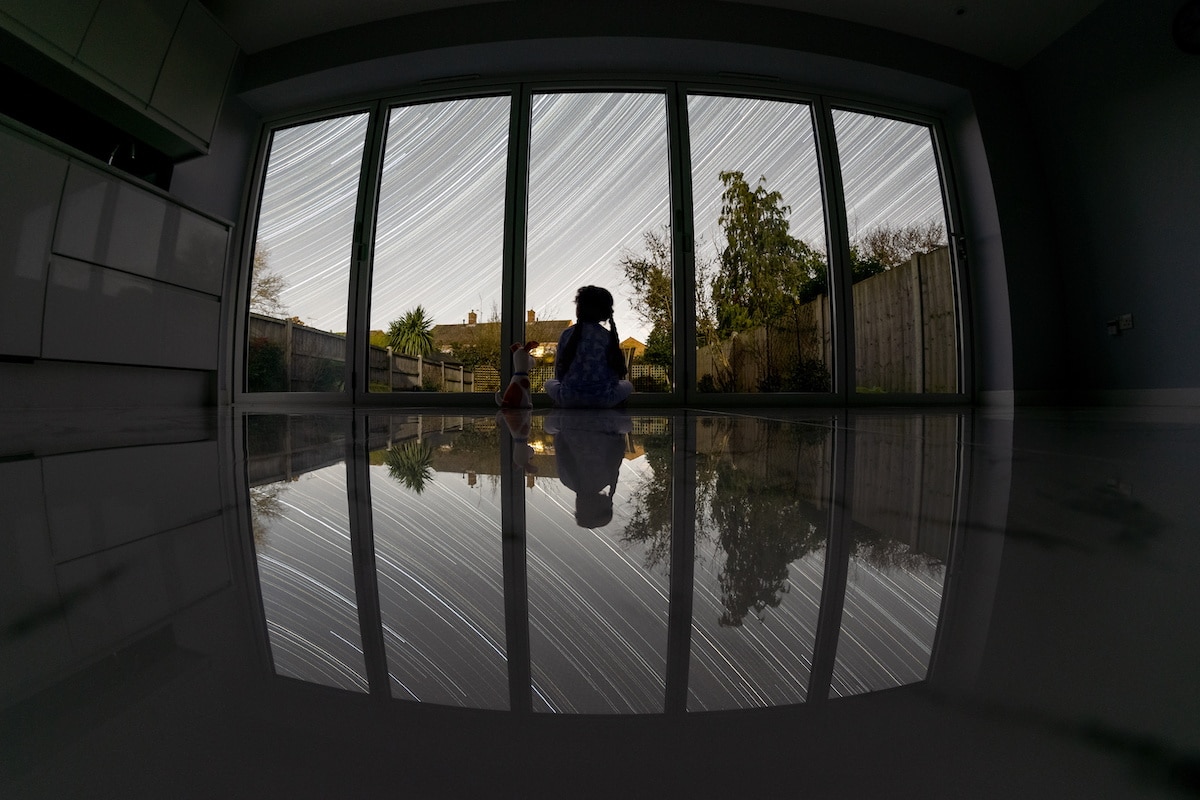
“Lockdown” by Deepal Ratnayaka (UK). Winner – People and Space.
With the UK being in full lockdown and travel restricted for many months due to the pandemic, astrophotography became the photographer’s focus. This photo sums up the year 2020 – cramped but hopeful. The photographer’s six-year-old daughter, who is always very interested in the photoshoots, was around during the setup. Sat by the door, she was showing the stars appearing one by one in the sky to her soft toy Max, and this gave the photographer the perfect opportunity to get her in the frame which complimented the message behind the photo.
Windsor, Berkshire, UK.
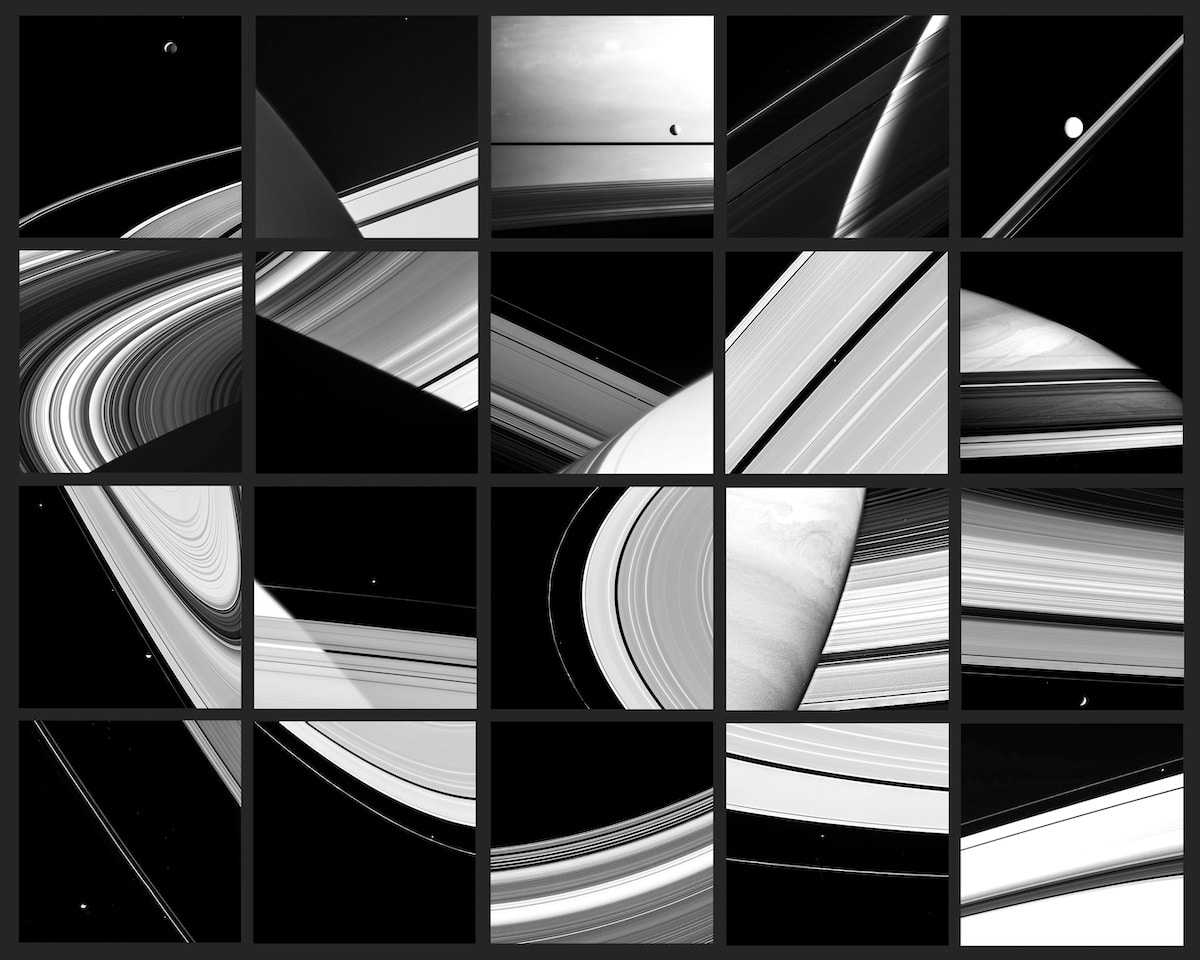
“Celestial Fracture” by Leonardo Di Maggio (UK). Winner (Joint) – The Annie Maunder Prize for Image Innovation.
The Cassini missions brought back some astounding imagery of our solar system. The photographer used a selection of the CICLOPS team’s photographs of Saturn to create this piece. The patterns formed by Saturn, its rings, and its moons are truly magnificent. The photographs have echoes of architecture, nature, art, and design, and are just as artistically inspirational as they are crucial for scientific study. The photographer edited several spectacular images before ordering the photographs into a grid pattern and assembled them in this particular way to have remnants of familiar and stable imagery, but in a fractured and disrupted way with undertones of science fiction symbolism.
Cassini Wide Angle Camera (September 2004–October 2007), visible light channel, NASA/JPL/Space Science Institute

“Family Photo of the Solar System” by 至璞 王 (Zhipu Wang) (China), aged 15. Winner – Young Competition.
This is an image of the Sun, the Moon, and the planets of the Solar System (except Earth) taken during the year of the rat in China. In this special year, the photographer felt very lucky to produce the images of these celestial bodies and for a student who has only practiced astrophotography for one year, it was a great accomplishment.
Yongtai, Fujian, China.

“Another Cloudy Day on Jupiter” by Sergio Díaz Ruiz (Spain). Winner (Joint) – The Annie Maunder Prize for Image Innovation.
High clouds on Jupiter create intricate and beautiful shapes that swirl all over the planet. In order to get a color image when there are only three color channels (red, green, blue), some sort of filter-to-channel mapping must be done. PixInsight was used for the rest of the processing: custom white balance, deconvolution, and wavelet transformation for detail enhancement, contrast, and saturation curves. The areas corresponding to the poles were too bright and distracting so they were darkened by color masking.
Hubble Space Telescope WFC3/UVIS (26–27 June 2019), FQ889, F631N, F502N, F395N, F467M, F658N, F275W, F343N channels, NASA/ESA HST Space Telescope, OPAL program (PI: Simon, GO13937)

“A Smiley in Space” by Nicolas Rolland (France) and Martin Pugh (Australia). Highly Commended – Galaxies.
NGC 1055 is an edge-on spiral galaxy with a prominent nuclear bulge crossed by a dark lane of gas and dust. It's a binary system with the galaxy Messier 77. Both are the largest galaxies of the galaxy group. This image has been processed using LRGB (luminance, red, green, blue) and hydrogen-alpha filters, CCDStack, PixInsight, and Photoshop. The colorful stars around NGC 1055 are in the foreground, inside the Milky Way. They look like the eyes of a cosmic smiley.
Río Hurtado, Coquimbo Region, Chile
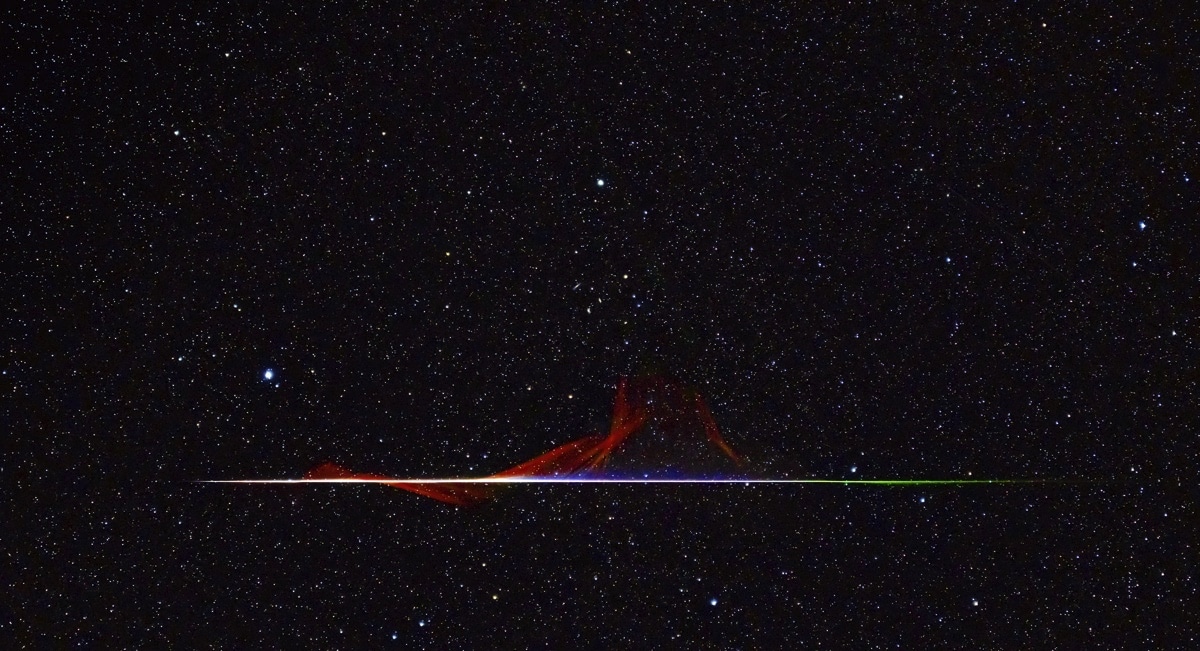
“A Colorful Quadrantid Meteor” by Frank Kuszaj (USA). Winner – Planets, Comets, and Asteroids.
The photographer was shooting with two other friends on that cold January evening. They weren’t planning to capture meteors but distant galaxies and nebulas. After setting up the camera to shoot the Leo Triplet galaxies, the photographer and his friends saw a bright green meteor burning right before their eyes as it tore through Earth’s atmosphere. They were all in awe of witnessing a fireball meteor. After they caught their breath, one of the friends mentioned that the photographer’s camera was pointing in the comet’s direction, but the photographer thought there was no way he could have caught it as he had zoomed all the way in. Once he checked his camera there it was – perfectly framed. The photographer had made a mistake and the lens wasn’t zoomed in, making the perfect composition for the meteor. This incredible image was a happy accident.
Cook Station, Missouri, USA, 19 January 2021
Astronomy Photographer of the Year: Website | Facebook | Instagram
My Modern Met granted permission to use photos by the Royal Observatory Greenwich.
Related Articles:
Spectacular Winners of the 2020 Astronomy Photographer of the Year Contest
Out of this World Winners of the 2019 Astronomy Photographer of the Year Contest
Spectacular Shortlist Announced for Astronomy Photographer of the Year Competition
Finalists of the Astronomy Photographer of the Year Contest Bring Us Exceptional Views of the Stars
"dazzling" - Google News
September 17, 2021 at 02:07AM
https://ift.tt/39aSVqz
Dazzling Winners of the Astronomy Photographer of the Year Contest - My Modern Met
"dazzling" - Google News
https://ift.tt/2SitLND
Shoes Man Tutorial
Pos News Update
Meme Update
Korean Entertainment News
Japan News Update
Bagikan Berita Ini















0 Response to "Dazzling Winners of the Astronomy Photographer of the Year Contest - My Modern Met"
Post a Comment